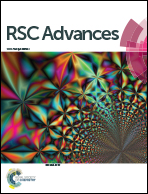Low-temperature preparation of macroscopic nitrogen-doped graphene hydrogel for high-performance ultrafast supercapacitors†
Abstract
In this work, a simple method by using ammonia at a relatively low temperature (90 °C) to prepare nitrogen-doped graphene hydrogel (N-GH) is demonstrated. Ammonia is not only a nitrogen source but also a modification to the 3D structure of graphene hydrogel. The structure and morphology characterization of the materials was characterized by scanning electron microscopy (SEM), X-ray diffraction (XRD) and Raman spectroscopy. The resulting N-GH has a high atomic percentage of N up to 13.44%. It has been found that the supercapacitor performance of the resulting N-GH could be significantly improved. At the constant current density of 1 A g−1, the specific capacitance was estimated as 217.8 F g−1. Even at the constant current density of 200 A g−1, the electrode still has a specific capacitance of 189.8 F g−1. The material also has a retention rate of 95.8% of its initial capacitance after 1000 cycles at a current density of 20 A g−1. Moreover, the N-GH has excellent electrochemical stability and a good performance for the rate property even at an ultrafast charge/discharge rate; thus, they may have potential applications as ultrafast supercapacitors.


 Please wait while we load your content...
Please wait while we load your content...